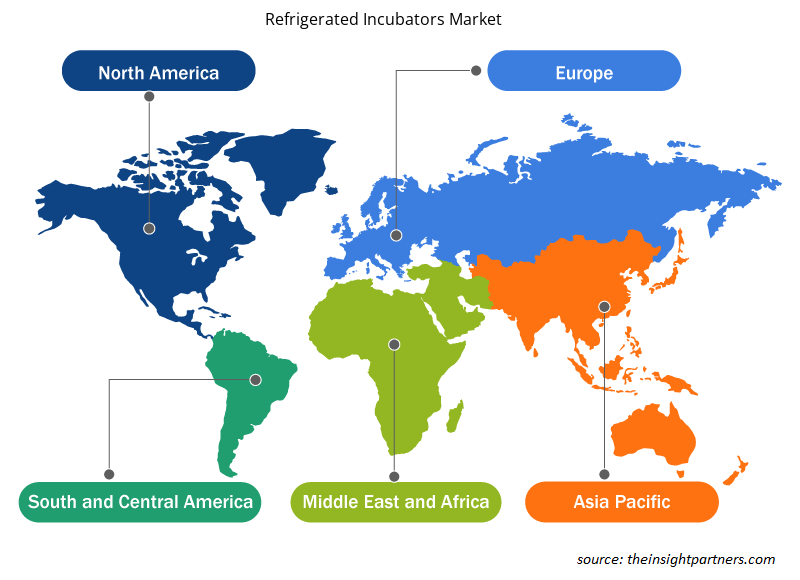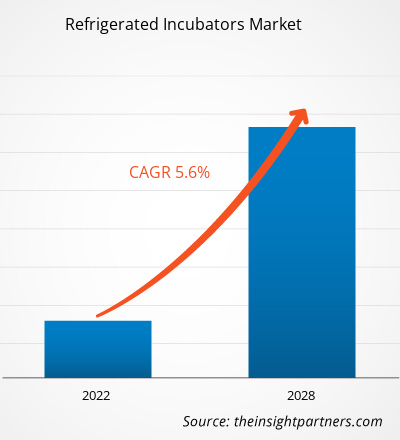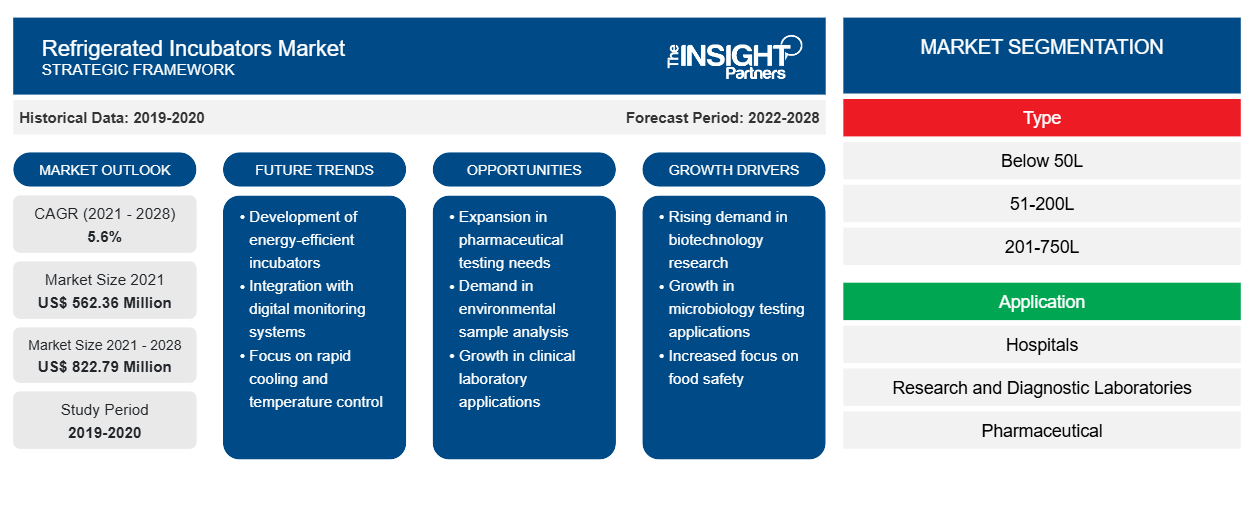Le marché des incubateurs réfrigérés devrait atteindre 822,79 millions de dollars américains d'ici 2028, contre 562,36 millions de dollars américains en 2021 ; il devrait croître à un TCAC de 5,6 % de 2021 à 2028.
L'adoption massive d'incubateurs réfrigérés par les centres de recherche ou les laboratoires stimule la croissance du marché. Dans le secteur médical, le travail avec des micro-organismes joue un rôle essentiel. La production et la multiplication efficaces de micro-organismes nécessitent une phase d'incubation stable. Avec l'avènement de la technologie, les chercheurs se sont tournés vers l'utilisation d'incubateurs ou d'équipements à technologie avancée visant une consommation économe en énergie par rapport aux incubateurs réfrigérés traditionnels. Par exemple, l'utilisation d'incubateurs réfrigérés dans les centres de recherche, les centres pharmaceutiques et biotechnologiques et les laboratoires est élevée car elle réduit la consommation d'énergie et minimise la distribution inégale de la température. En outre, plusieurs acteurs compétitifs de premier plan, tels que Binder GmBH, conçoivent des incubateurs réfrigérés dotés de caractéristiques uniques, telles qu'une unité de réfrigération par compression, garantissant un flux de température constant. En outre, les incubateurs réfrigérés fonctionnent avec une technologie conventionnelle particulière assurant une température stable et continue à l'intérieur de la chambre d'incubation.
En outre, avec les avancées et la croissance importantes dans le domaine de la biologie grâce à l'afflux de produits pharmaceutiques, de zoologie, de microbiologie, de génétique et d'écologie, la demande d'incubateurs réfrigérés à technologie avancée est plus élevée que jamais. Les principaux acteurs compétitifs, tels que Being Scientific Inc., proposent des incubateurs réfrigérés à technologie avancée pour faciliter la croissance et le stockage d'échantillons biologiques. En outre, les offres de produits de la société sont fortement orientées vers la conception d'incubateurs réfrigérés à technologie avancée comprenant des applications critiques. Il s'agit notamment de la demande biologique en oxygène (DBO), efficace pour les tests des eaux usées ayant une grande applicabilité dans les laboratoires de microbiologie, les laboratoires de biologie cellulaire et les laboratoires pharmaceutiques, s'avérant efficace pour le stockage de médicaments et d'échantillons biologiques. Par conséquent, l'augmentation des activités de R&D et les principaux acteurs contribuant aux lancements de produits innovants liés aux incubateurs réfrigérés se traduisent par une forte acceptation dans le monde entier. De telles activités propulsent encore plus les ventes sur le marché mondial des incubateurs réfrigérés
Personnalisez ce rapport en fonction de vos besoins
Vous bénéficierez d'une personnalisation gratuite de n'importe quel rapport, y compris de certaines parties de ce rapport, d'une analyse au niveau des pays, d'un pack de données Excel, ainsi que de superbes offres et réductions pour les start-ups et les universités.
- Obtenez les principales tendances clés du marché de ce rapport.Cet échantillon GRATUIT comprendra une analyse de données, allant des tendances du marché aux estimations et prévisions.
Français L'adoption croissante des incubateurs réfrigérés et l'augmentation du financement gouvernemental ciblant les activités de R&D offriraient des opportunités lucratives pour le marché mondial des incubateurs réfrigérés au cours de la période de prévision. Le rapport de la Public Library of Science (PLOS) indique qu'au cours des dernières années, de nombreux défis ont été observés liés à la lutte contre les maladies infectieuses émergentes, en particulier la résistance aux antimicrobiens (RAM) et les maladies négligées (MN). Par exemple, le Groupe de travail consultatif d'experts (CEWG) se concentre sur le financement de la R&D, et la coordination au sein de l'Organisation mondiale de la santé (OMS) a suggéré de rechercher des alternatives liées au financement et à l'incitation de la R&D pour l'innovation et l'accès aux maladies infectieuses émergentes. Pour mémoire, le CEWG et la Lancet Commission ont annoncé un financement mondial des soins de santé de 6 milliards de dollars par an pour la résistance aux antimicrobiens (RAM) et de 10 milliards de dollars pour les infections émergentes. Par conséquent, avec l'augmentation des activités de R&D ciblant les maladies infectieuses émergentes et la RAM, l'adoption des incubateurs réfrigérés a considérablement augmenté au fil des ans.
Actuellement, les fabricants consacrent des fonds à des activités de recherche et développement afin de lancer des produits à base d'incubateurs réfrigérés rentables et sophistiqués dans le monde entier. Des acteurs compétitifs de premier plan, tels que Thermo Fischer Scientific, ont annoncé le lancement de nouveaux incubateurs réfrigérés sur les marchés régionaux, tels que l'Europe, l'Asie-Pacifique et l'Amérique latine. Les systèmes sont capables d'une large application dans les domaines pharmaceutique, des sciences de la vie, du traitement de l'eau, de l'industrie microbiologique et des tests de DBO. Les facteurs susmentionnés renforceraient la croissance du marché mondial des incubateurs réfrigérés au cours de la période 2021-2028.
L'Amérique du Nord devrait dominer le marché mondial des incubateurs réfrigérés au cours de la période 2021-2028. Les États-Unis détiennent la plus grande part de marché dans cette région. Selon le rapport Clinical Trials.gov, la New York Stem Cell Foundation (NYSCF) mène des recherches pour étudier différentes conditions et maladies en utilisant des cellules souches et d'autres types de cellules, en menant des recherches sur des échantillons biologiques, en effectuant des tests génétiques et en stockant ces échantillons pendant une courte durée en vue d'une utilisation ultérieure. De plus, les chercheurs des laboratoires américains créent des cellules productrices d'insuline pancréatine pour identifier le diabète de type 1, les cellules cérébrales et la maladie de Parkinson. De tels facteurs soutiennent fortement l'adoption d'incubateurs réfrigérés dans les laboratoires américains. En outre, aux États-Unis seulement, il existe plus de 40 000 laboratoires de recherche individuels situés sur des campus universitaires impliqués dans l'avancement du domaine des sciences biologiques et biomédicales. La recherche comprend de vastes échantillons biologiques provenant d'études cliniques et sur le terrain, représentant une énorme valeur scientifique et financière pour les chercheurs et les organisations, telles que les sociétés biotechnologiques/pharmaceutiques, les biobanques, les instituts de recherche et les universités. Les facteurs susmentionnés devraient propulser la croissance du marché mondial des incubateurs réfrigérés au cours de la période de prévision.
Informations sur les applications
En fonction des applications, le marché mondial des incubateurs réfrigérés est segmenté en hôpitaux, laboratoires de recherche et de diagnostic ; sociétés pharmaceutiques, cosméceutiques et biotechnologiques ; instituts de recherche et universitaires ; et autres. Le segment des hôpitaux, des laboratoires de recherche et de diagnostic devrait représenter la plus grande part de marché au cours de la période 2021-2028. Les hôpitaux jouent un rôle important en offrant une vaste gamme de services médicaux aux patients souffrant de diverses maladies. Par conséquent, l'adoption croissante des incubateurs réfrigérés dans les hôpitaux est élevée en raison de la prévalence croissante des infections chroniques et d'un meilleur traitement des troubles complexes. De plus, dans les laboratoires de recherche et de diagnostic, l'adoption de ces incubateurs est importante car le stockage des échantillons nécessite différents types d'incubateurs réfrigérés. Ainsi, les facteurs susmentionnés stimuleraient la croissance du marché mondial des incubateurs réfrigérés pour ce segment au cours de la période 2021-2028.
Les entreprises opérant sur le marché mondial des incubateurs réfrigérés adoptent la stratégie d'innovation produit pour répondre aux demandes évolutives des clients dans le monde entier, ce qui leur permet également de maintenir leur nom de marque sur le marché mondial.
Aperçu régional du marché des incubateurs réfrigérés
Les tendances et facteurs régionaux influençant le marché des incubateurs réfrigérés tout au long de la période de prévision ont été expliqués en détail par les analystes d’Insight Partners. Cette section traite également des segments et de la géographie du marché des incubateurs réfrigérés en Amérique du Nord, en Europe, en Asie-Pacifique, au Moyen-Orient et en Afrique, ainsi qu’en Amérique du Sud et en Amérique centrale.

- Obtenez les données régionales spécifiques au marché des incubateurs réfrigérés
Portée du rapport sur le marché des incubateurs réfrigérés
| Attribut de rapport | Détails |
|---|---|
| Taille du marché en 2021 | 562,36 millions de dollars américains |
| Taille du marché d'ici 2028 | 822,79 millions de dollars américains |
| Taux de croissance annuel moyen mondial (2021-2028) | 5,6% |
| Données historiques | 2019-2020 |
| Période de prévision | 2022-2028 |
| Segments couverts | Par type
|
| Régions et pays couverts | Amérique du Nord
|
| Leaders du marché et profils d'entreprises clés |
|
Densité des acteurs du marché des incubateurs réfrigérés : comprendre son impact sur la dynamique des entreprises
Le marché des incubateurs réfrigérés connaît une croissance rapide, tirée par la demande croissante des utilisateurs finaux en raison de facteurs tels que l'évolution des préférences des consommateurs, les avancées technologiques et une plus grande sensibilisation aux avantages du produit. À mesure que la demande augmente, les entreprises élargissent leurs offres, innovent pour répondre aux besoins des consommateurs et capitalisent sur les tendances émergentes, ce qui alimente davantage la croissance du marché.
La densité des acteurs du marché fait référence à la répartition des entreprises ou des sociétés opérant sur un marché ou un secteur particulier. Elle indique le nombre de concurrents (acteurs du marché) présents sur un marché donné par rapport à sa taille ou à sa valeur marchande totale.
Les principales entreprises opérant sur le marché des incubateurs réfrigérés sont :
- Binder GmbHGmbH
- Thermo Fischer Scientific Inc. Fischer Scientific Inc.
- Société de portefeuille PHC Holding Corporation
- Eppendorf AG AG
- Amerex Instruments, Inc. Instruments, Inc.
Avis de non-responsabilité : les sociétés répertoriées ci-dessus ne sont pas classées dans un ordre particulier.

- Obtenez un aperçu des principaux acteurs du marché des incubateurs réfrigérés
Marché mondial des incubateurs réfrigérés – Segmentation
Français En fonction du type, le marché mondial des incubateurs réfrigérés est segmenté en moins de 50 L, 51-200 L, 201-750 L, 751-1500 L et plus de 1501 L. Par application, le marché est segmenté en hôpitaux, laboratoires de recherche et de diagnostic ; sociétés pharmaceutiques, cosméceutiques et biotechnologiques ; instituts de recherche et universitaires ; et autres. En fonction de la géographie, le marché mondial des incubateurs réfrigérés est principalement segmenté en Amérique du Nord, Europe, Asie-Pacifique, Moyen-Orient et Afrique (MEA) et Amérique du Sud et centrale. Le marché en Amérique du Nord est en outre segmenté en États-Unis, Canada et Mexique. Le marché européen des incubateurs réfrigérés est sous-segmenté en France, Allemagne, Royaume-Uni, Espagne, Italie et reste de l'Europe. Le marché de l'Asie-Pacifique est sous-segmenté en Chine, Inde, Japon, Australie, Corée du Sud et reste de l'APAC. Le marché des incubateurs réfrigérés au Moyen-Orient et en Afrique est subdivisé en Arabie saoudite, aux Émirats arabes unis, en Afrique du Sud et dans le reste du Moyen-Orient et de l'Afrique. Le marché de l'Amérique du Sud et de l'Amérique centrale est subdivisé en Brésil, en Argentine et dans le reste de l'Amérique du Sud et de l'Amérique centrale.
Profils d'entreprise
- Binder GmbH
- Thermo Fischer Scientific Inc.
- Société de portefeuille PHC
- Eppendorf AG
- Amerex Instruments, Inc.
- Sheldon Fabrication, Inc.
- LEEC Ltée.
- Memmert GmbH+ Co. KG
- Référence scientifique
- Gilson Inc.
- Analyse historique (2 ans), année de base, prévision (7 ans) avec TCAC
- Analyse PEST et SWOT
- Taille du marché Valeur / Volume - Mondial, Régional, Pays
- Industrie et paysage concurrentiel
- Ensemble de données Excel
Rapports récents
Témoignages
Raison d'acheter
- Prise de décision éclairée
- Compréhension de la dynamique du marché
- Analyse concurrentielle
- Connaissances clients
- Prévisions de marché
- Atténuation des risques
- Planification stratégique
- Justification des investissements
- Identification des marchés émergents
- Amélioration des stratégies marketing
- Amélioration de l'efficacité opérationnelle
- Alignement sur les tendances réglementaires





















 Obtenez un échantillon gratuit pour - Marché des incubateurs réfrigérés
Obtenez un échantillon gratuit pour - Marché des incubateurs réfrigérés